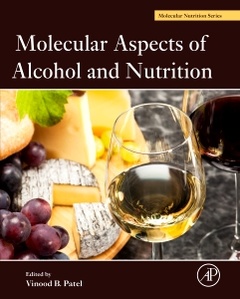Molecular Aspects of Alcohol and Nutrition A Volume in the Molecular Nutrition Series
Coordonnateur : Patel Vinood B.

Molecular Aspects of Alcohol and Nutrition is a valuable resource for nutrition researchers and nutritionists who study or treat alcohol-related diseases. Experts from across the field of alcohol research explain how alcohol disrupts normal fat, carbohydrate, and protein metabolic processes occurring in the liver as well as other parts of the body.
The book discusses how this can lead to alcoholic liver disease (ALD) as well as contribute to the onset of Type 2 diabetes and the metabolic syndrome. It also explores how alcohol affects nutrient absorption in the gastrointestinal tract and can lead to anemia and reduced amounts of fat soluble vitamins.
This book explores both the primary and secondary consequences of alcohol consumption. Chapters in the first section investigate the basic science of alcohol metabolism ? focusing on how alcohol and its toxic metabolites disrupt and impair normal nutrient regulation at the molecular level. Further chapters explore how alcohol affects many extra-hepatic organs and tissues as well as the secondary consequences of alcohol consumption such as reduced levels of minerals like magnesium, calcium, and trace elements like zinc.
Section 1. General and Introductory Aspects 1. Nutrients and Liver Energy Metabolism Daniel Gyamfi and Kwabena Owusu Danquah 2. Alcohol Metabolism: general aspects Reem Ghazali and Vinood B. Patel Section 2. Molecular biology of the cell 3. Alcohol and aldehyde dehydrogenases: molecular aspects Kwabena Owusu Danquah 4. Apoptosis and alcohol F.A. Middleton 5. Pathogenic Mechanisms in Alcoholic Liver Disease (ALD): emerging role of Osteopontin Wing-Kin Syn and Jason D. Coombes 6. The Role of CD36 in the Pathogenesis of Alcohol-Related Disease Caleb T. Epps, Robin D. Clugston, Amit Saha, William S. Blaner and Li-Shin Huang 7. Thiamine deficiency in alcoholics Ann M. Manzardo 8. Vitamin B regulation of Alcoholic Liver Disease Charles H. Halsted and Valentina Medici 9. Vitamin D and alcohol interactions and implication for bone Emilio Gonzalez-Reimers, Geraldine Quintero-Platt, Antonio Martinez-Riera and Francisco Santolaria-Fernandez 10. Antioxidant treatment of alcoholism Camila Siqueira Silva, Helio Vannucchi and Guilherme Vannucchi Portari 11. Selenium dietary supplementation and oxidative balance in alcoholism Olimpia Carreras, María Luisa Ojeda and Fatima Nogales 12. Role of zinc in alcoholic liver disease Zhanxiang Zhou 13. Interactions between alcohol and folate Bogdan Cylwik 14. Effects of Acetladehyde on intestinal barrier function D. Jonkers and Elhaseen Elamin 15. Cholesterol regulation by leptin in alcoholic liver disease Balasubramaniyan Vairappan 16. CRF system and alcohol consumption Andrey E. Ryabinin and William J. Giardino 17. Metabolic profiling approaches for biomarkers of ethanol intake Helen G. Gika and Ian D. Wilson Section 3. Genetic machinery and its function 18. Gene expression in alcoholism: an overview Reem Ghazali and Vinood B. Patel 19. Cytochrome P4502E1 Gene Polymorphisms in alcoholics Tao Zeng and K.-Q. Xie 20. Genes associated with alcohol withdrawal Kesheng Wang and Liang Wang 21. Alcohol and epigenetic modulations Claudio D'Addario and Mauro Maccarrone 22. miRNA Expression in the alcoholic liver disease Shashi Bala 22. Alcohol and DNA Methylation Feng C. Zhou 24. Ethanol-mediated carcinogenesis molecular insights as an overview Helmut K. Seitz 25. Molecular link between alcohol and breast cancer: the role of salsolinol Mariko Murata, Kaoru Midorikawa and Shosuke Kawanishi 26. Ethanol impairs Phospholipase D signaling in astrocytes Ute Burkhardt and Jochen Klein 27. Metabolite changes in alcohol gonadotoxicity Ganna M. Shayakhmetova and Larysa B. Bondarenko 28. Hepcidin and iron dysregulation in alcoholics Kosha Mehta and Vinood B. Patel
- Offers a valuable resource for nutrition researchers and nutritionists who study alcohol-related diseases and attempt to treat them through nutritional strategies
- Explores how alcohol and its toxic metabolite acetaldehyde disrupt and impair normal macro and micro nutrient regulation at the molecular level
- Investigates how alcohol affects and interferes with cell signaling, cell death pathways, calcium homeostasis leading to osteoporosis, oxygen balance, as well as the pathophysiology of alcohol consumption and abuse
Date de parution : 11-2015
Ouvrage de 400 p.
21.4x27.6 cm
Thèmes de Molecular Aspects of Alcohol and Nutrition :
Mots-clés :
acetaldehyde; alcohol; alcohol dependence; alcohol drinking; alcohol metabolism; alcohol withdrawal; alcohol withdrawal symptoms; alcoholic fatty liver disease; alcoholic liver disease; alcoholic pancreatitis; alcoholism; alcoholism symptoms and recovery; ALD; aldehyde dehydrogenase; alternative splicing; amino acid; amygdala; antioxidant treatment; antioxidants enzymes; apoptosis; barrier; benfotiamine; bile acids; biomarkers; bone alterations; brain alterations; brain growth spurt; brain serotonin genes; breast cancer; calcium signaling; candidate gene; carbohydrates; CD36; cell death; cell proliferation; cirrhosis; CNS; copy-number variation; corticotropin releasing factor; cytochrome P450-2E1; cytochrome P4502E1; cytokines; DNA methylation; dopamine; Edinger-Westphal nucleus; endotoxemia; energy; epigenetics; epithelium; estrogen activity; estrogens; ethanol; exosomes; extracellular vesicles (EVs); fatty acid; fatty acid oxidation; fatty liver; fatty-acid transport; fetal alcohol syndrome genes; fibrosis; folate; folate deficiency; folate metabolism; free radicals; gene expression; gene ontology; gene polymorphism; gene-environment interaction; gene-gene interaction; genetic risks; genetics; genome-wide association study; glucose; gonadotoxicity; GPx; hemochromatosis; hepatic steatosis; hepatocellular cancer; hepcidin; histone acetylation; histone methylation; histone modifications; HNF-4α; hypercholesterolemia; hypogonadism; hypothalamus; immune; inflammation; inflammatory cytokines; intestinal permeability; intestine; iron; linkage study; lipids; liver; liver disease; LNA; matricellular protein; metabolic changes; metabolic profiling



